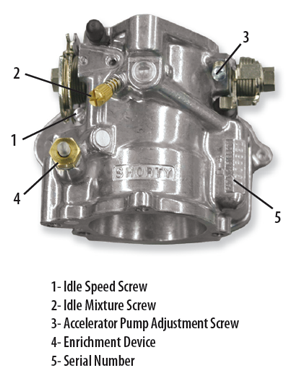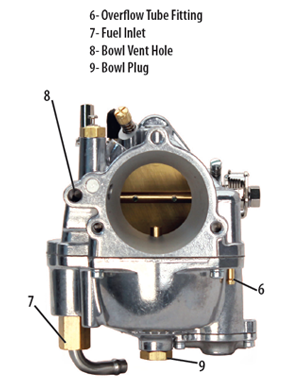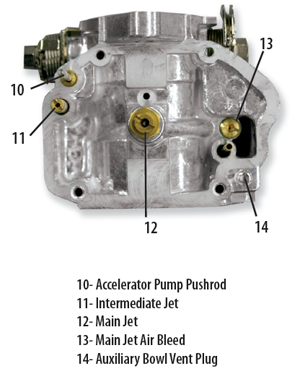Carb Quick Guide
- Verify carburetor is set to stock settings:
- Idle mixture screw, 1 1/4 turns from lightly seated.
- Idle speed screw, 1/2 turn clockwise from engagement point.
- Accelerator adjustment screw, two turns counter-clockwise from seated.
- Start bike, bring to operating temperature.
- Set idle speed adjusting screw, clockwise to increase rpm, counter-clockwise to decrease rpm. Idle rpm range should be 950 to 1050 rpms.
- Adjust idle mixture by turning idle mixture screw slowly clockwise until the engine runs poorly. Note position. Slowly turn the screw counter-clockwise until it starts to stumble. Note position. Set the idle mixture screw halfway between the positions, or at the strongest idle. Inconsistent idle may indicate a manifold leak.
- With engine idling, turn accelerator adjustment screw clockwise until it lightly seats. Snap throttle open—engine should stumble. Turn screw counter-clockwise 1/4 or 1/2 of a turn at a time, until engine responds to throttle twist with smooth, quick response.
- Ride motorcycle in various rpm ranges, and then try to maintain a consistent 40- to 50-mph. If the engine has a flat spot, or is popping/sneezing in the air cleaner, it can indicate a lean condition. If you notice stumbling or sputtering, it can indicate a rich condition.
- Low rpm operation is controlled by the intermediate jet (#11). If sneezing or popping is experienced below approximately 3000 rpm’s the intermediate jet must be replaced with a larger sized (richer) jet. If the engine does not run smoothly at low speeds, fouls plugs, blows black smoke or gets bad gas mileage a smaller (leaner) intermediate jet needs to be installed. Always readjust the idle mixture (#2) and idle speed (#1) screws after making a jet change.
- To test the main jet, do a roll-on from 50-mph to 70-mph in 3rd gear. If the engine backfires or breaks up in the carb, increase the main jet size .004". If the engine is flat or will not accelerate, decrease the main jet by .004".
- Since 2004 S&S shorty carbs have been fitted with an adjustable main jet air bleed (#13). Changing this jet to a larger size will delay the signal to the main jet, therefore aiding with high speed tuning as described in step 8. This also aides with tuning an engine that is fitted with an exhaust system that is not intended for high performance. The air bleed uses main jets, the stock size is 40. If it needs to be changed the range is normally 50 to 60.
- NOTE: Drag or straight pipes, especially large diameter or long designs, can prevent you from obtaining optimum carburetor performance.
- If the S&S teardrop air cleaner is being replaced with an aftermarket air cleaner, be sure to remove the auxiliary bowl vent screw (#14). Never use a velocity stack on a street driven motorcycle! Poor throttle response will be experienced.
- Always be sure to attach the hose to the overflow tube fitting (#6) and route it toward the back of the engine.


